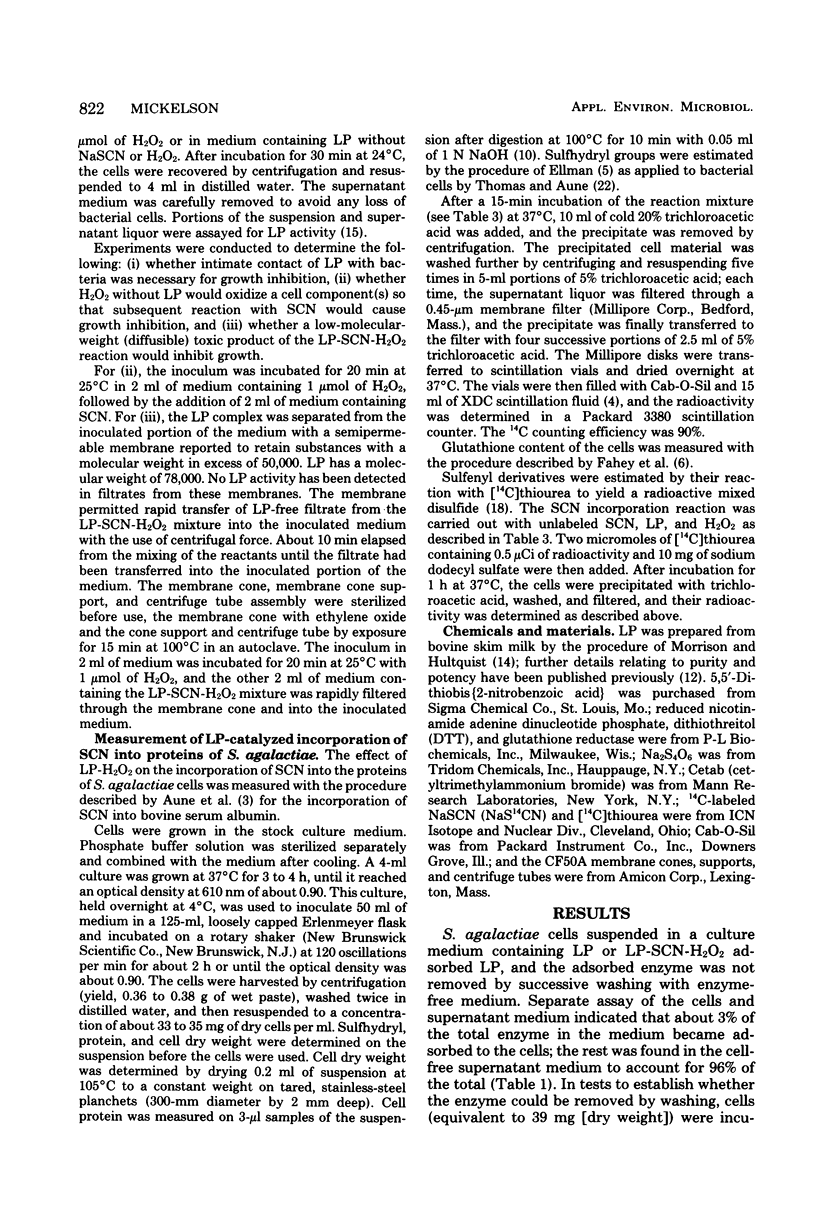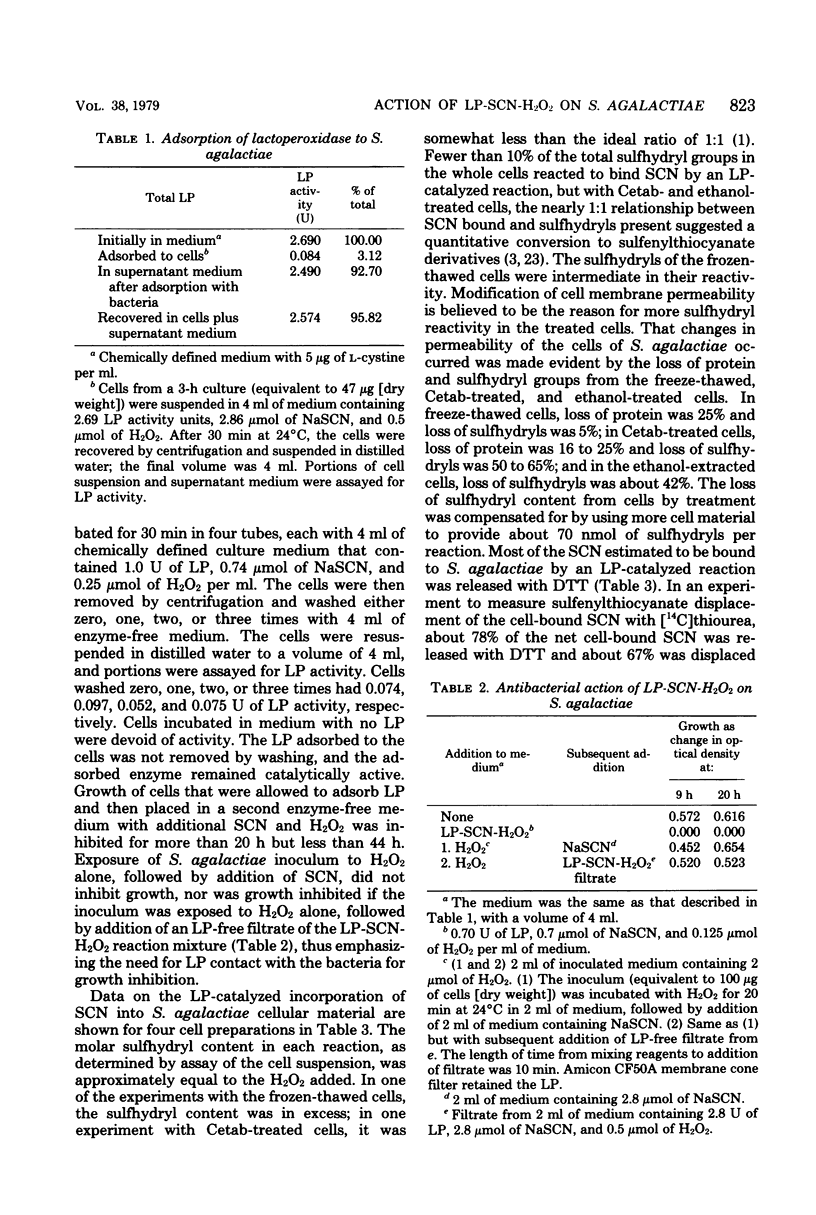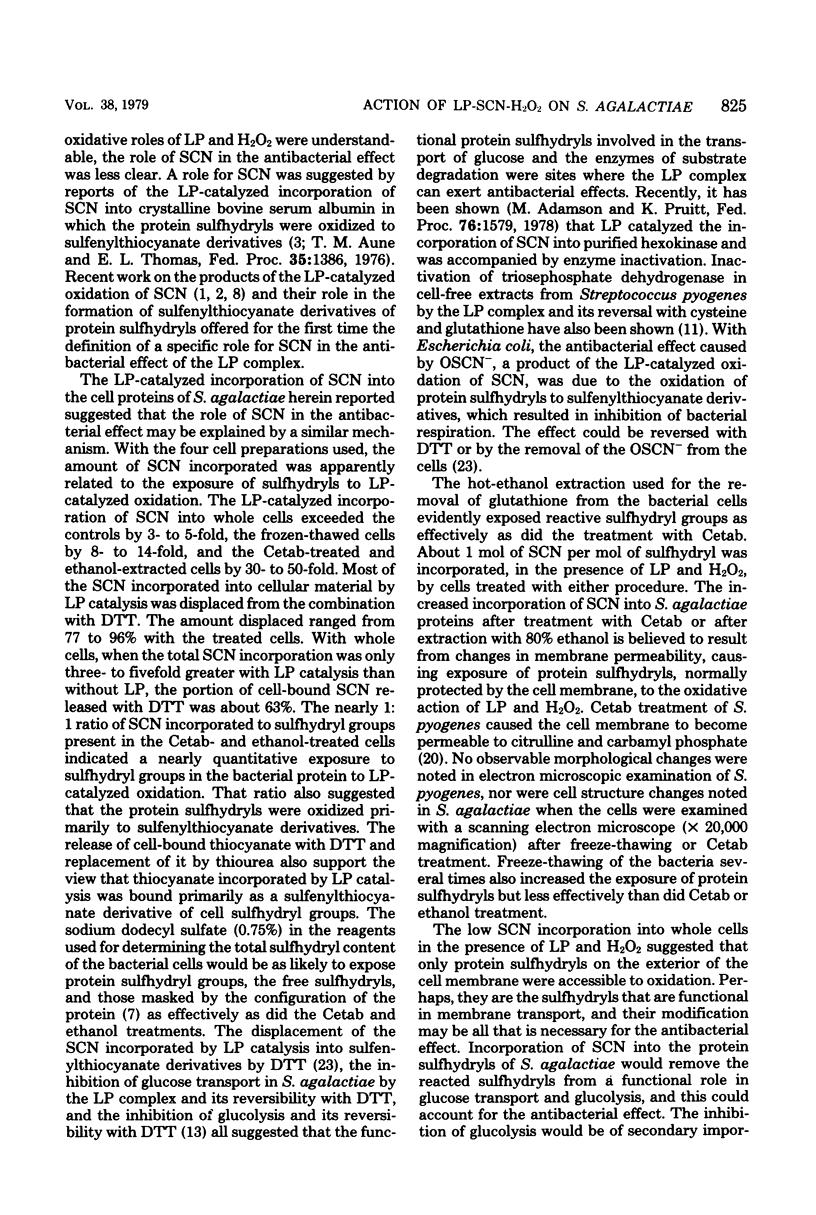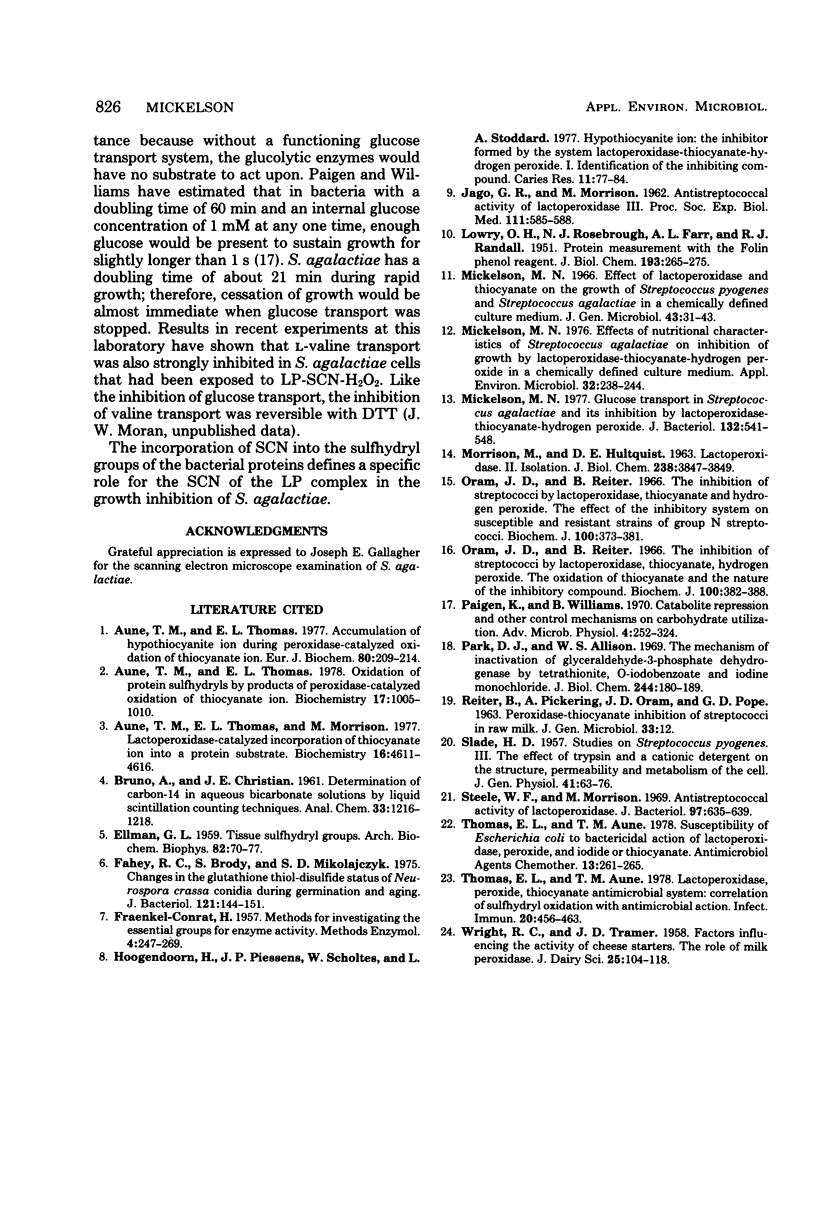Abstract
Antibacterial activity of lactoperoxidase (LP)-thiocyanate (SCN)-hydrogen peroxide (H2O2) on Streptococcus agalactiae requires that the three reactants must be in contact with the cells simultaneously. Small but assayable amounts of LP adsorb to the cell surface and are not removed by washing. A diffusible antibacterial product of LP-SCN-H2O2 reaction was not found under our experimental conditions. Incubation of S. agalactiae cells with LP-H2O2 and 14C-labeled sodium SCN resulted in the incorporation of SCN into the bacterial protein. Most of the LP-catalyzed, incorporated SCN was released from the bacterial protein. Most of the LP-catalyzed, incorporated SCN was released from the bacterial protein with dithiothreitol. Cells that had their membrane permeability changed by treatment with Cetab or 80% ethanol incorporated more SCN than did untreated cells, i.e., approximately 1 mol of SCN for each mol of sulfhydryl group present in the reaction mixture. Alteration of membrane permeability caused protein sulfhydryls, normally protected by the cytoplasmic membrane, to become exposed to oxidation. The results suggest the LP-H2O2-catalyzed incorporation of SCN into the proteins of S. agalactiae by a mechanism similar to that reported for bovine serum albumin. Removal of reactive protein sulfhydryls from a functional role in membrane transport and in glucolysis in a likely cause of the antibacterial effect for S. agalactiae.
Full text
PDF





Selected References
These references are in PubMed. This may not be the complete list of references from this article.
- Aune T. M., Thomas E. L. Accumulation of hypothiocyanite ion during peroxidase-catalyzed oxidation of thiocyanate ion. Eur J Biochem. 1977 Oct 17;80(1):209–214. doi: 10.1111/j.1432-1033.1977.tb11873.x. [DOI] [PubMed] [Google Scholar]
- Aune T. M., Thomas E. L., Morrison M. Lactoperoxidase-catalyzed incorporation of thiocyanate ion into a protein substrate. Biochemistry. 1977 Oct 18;16(21):4611–4615. doi: 10.1021/bi00640a013. [DOI] [PubMed] [Google Scholar]
- Aune T. M., Thomas E. L. Oxidation of protein sulfhydryls by products of peroxidase-catalyzed oxidation of thiocyanate ion. Biochemistry. 1978 Mar 21;17(6):1005–1010. doi: 10.1021/bi00599a010. [DOI] [PubMed] [Google Scholar]
- ELLMAN G. L. Tissue sulfhydryl groups. Arch Biochem Biophys. 1959 May;82(1):70–77. doi: 10.1016/0003-9861(59)90090-6. [DOI] [PubMed] [Google Scholar]
- Fahey R. C., Brody S., Mikolajczyk S. D. Changes in the glutathione thiol-disulfide status of Neurospora crassa conidia during germination and aging. J Bacteriol. 1975 Jan;121(1):144–151. doi: 10.1128/jb.121.1.144-151.1975. [DOI] [PMC free article] [PubMed] [Google Scholar]
- Hoogendoorn H., Piessens J. P., Scholtes W., Stoddard L. A. Hypothiocyanite ion; the inhibitor formed by the system lactoperoxidase-thiocyanate-hydrogen peroxide. I. Identification of the inhibiting compound. Caries Res. 1977;11(2):77–84. doi: 10.1159/000260252. [DOI] [PubMed] [Google Scholar]
- JAGO G. R., MORRISON M. Anti-streptococcal activity of lactoperoxidase III. Proc Soc Exp Biol Med. 1962 Dec;111:585–588. doi: 10.3181/00379727-111-27862. [DOI] [PubMed] [Google Scholar]
- LOWRY O. H., ROSEBROUGH N. J., FARR A. L., RANDALL R. J. Protein measurement with the Folin phenol reagent. J Biol Chem. 1951 Nov;193(1):265–275. [PubMed] [Google Scholar]
- Mickelson M. N. Effects of nutritional characteristics of Streptococcus agalactiae on inhibition of growth by lactoperoxidase-thiocyanate-hydrogen peroxide in chemically defined culture medium. Appl Environ Microbiol. 1976 Aug;32(2):238–244. doi: 10.1128/aem.32.2.238-244.1976. [DOI] [PMC free article] [PubMed] [Google Scholar]
- Mickelson M. N. Glucose transport in Streptococcus agalactiae and its inhibition by lactoperoxidase-thiocyanate-hydrogen peroxide. J Bacteriol. 1977 Nov;132(2):541–548. doi: 10.1128/jb.132.2.541-548.1977. [DOI] [PMC free article] [PubMed] [Google Scholar]
- Oram J. D., Reiter B. The inhibition of streptococci by lactoperoxidase, thiocyanate and hydrogen peroxide. The effect of the inhibitory system on susceptible and resistant strains of group N streptococci. Biochem J. 1966 Aug;100(2):373–381. doi: 10.1042/bj1000373. [DOI] [PMC free article] [PubMed] [Google Scholar]
- Oram J. D., Reiter B. The inhibition of streptococci by lactoperoxidase, thiocyanate and hydrogen peroxide. The oxidation of thiocyanate and the nature of the inhibitory compound. Biochem J. 1966 Aug;100(2):382–388. doi: 10.1042/bj1000382. [DOI] [PMC free article] [PubMed] [Google Scholar]
- Parker D. J., Allison W. S. The mechanism of inactivation of glyceraldehyde 3-phosphate dehydrogenase by tetrathionate, o-iodosobenzoate, and iodine monochloride. J Biol Chem. 1969 Jan 10;244(1):180–189. [PubMed] [Google Scholar]
- SLADE H. D. Studies on Streptococcus pyogenes. III. The effect of trypsin and a cationic detergent on the structure, permeability, and metabolism of the cell. J Gen Physiol. 1957 Sep 20;41(1):63–76. doi: 10.1085/jgp.41.1.63. [DOI] [PMC free article] [PubMed] [Google Scholar]
- Steele W. F., Morrison M. Antistreptococcal activity of lactoperoxidase. J Bacteriol. 1969 Feb;97(2):635–639. doi: 10.1128/jb.97.2.635-639.1969. [DOI] [PMC free article] [PubMed] [Google Scholar]
- Thomas E. L., Aune T. M. Lactoperoxidase, peroxide, thiocyanate antimicrobial system: correlation of sulfhydryl oxidation with antimicrobial action. Infect Immun. 1978 May;20(2):456–463. doi: 10.1128/iai.20.2.456-463.1978. [DOI] [PMC free article] [PubMed] [Google Scholar]
- Thomas E. L., Aune T. M. Susceptibility of Escherichia coli to bactericidal action of lactoperoxidase, peroxide, and iodide or thiocyanate. Antimicrob Agents Chemother. 1978 Feb;13(2):261–265. doi: 10.1128/aac.13.2.261. [DOI] [PMC free article] [PubMed] [Google Scholar]


